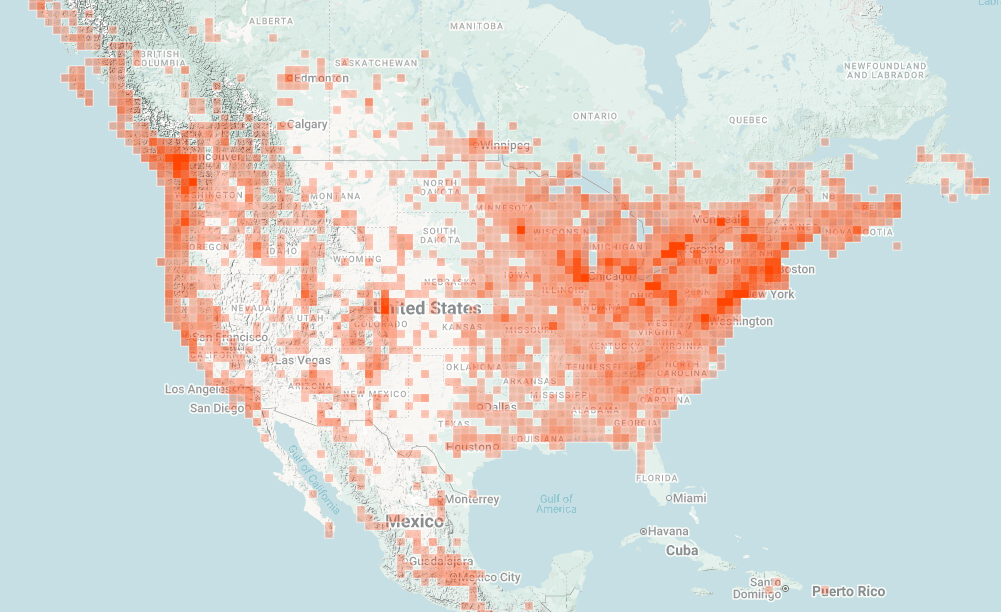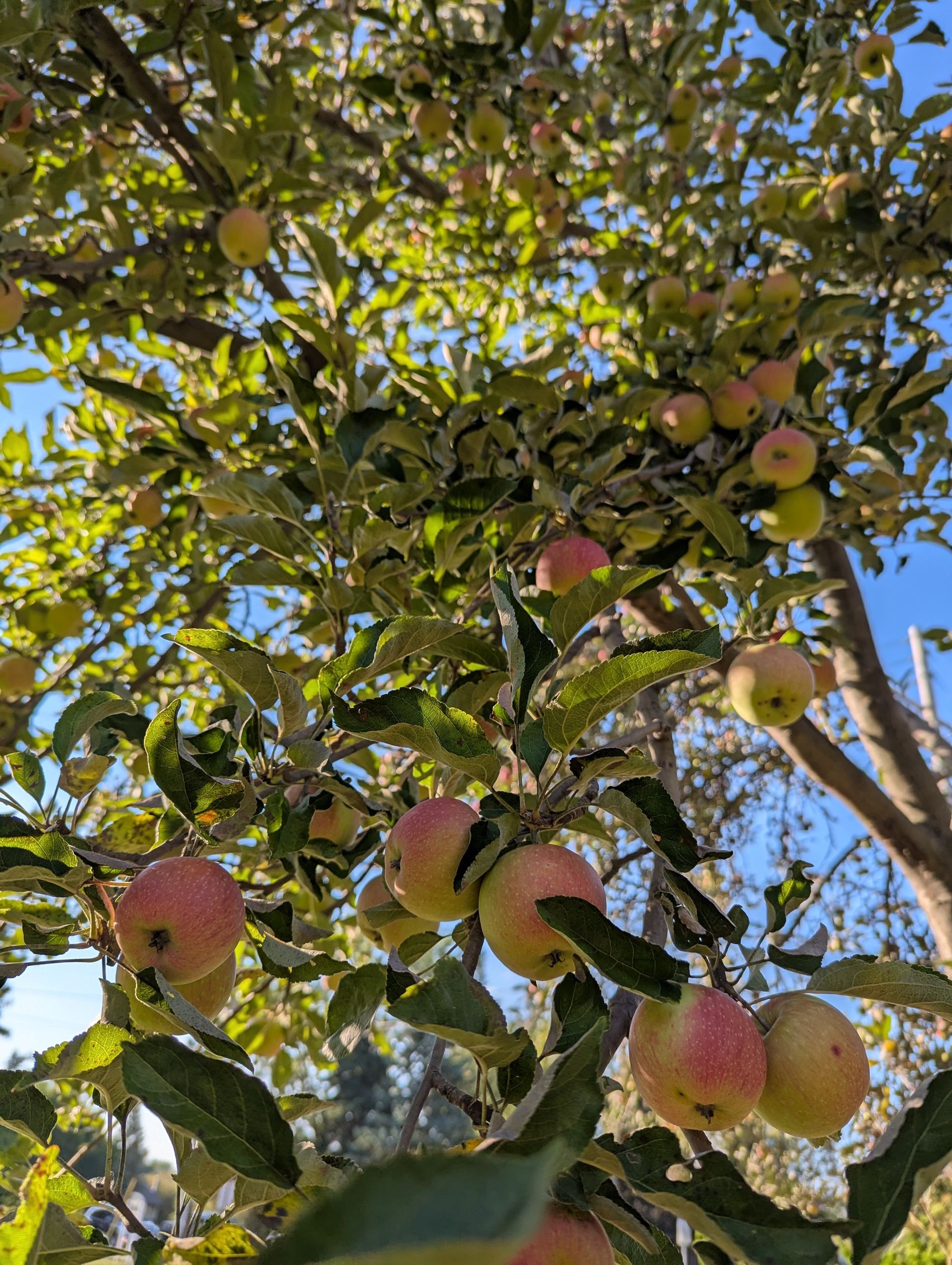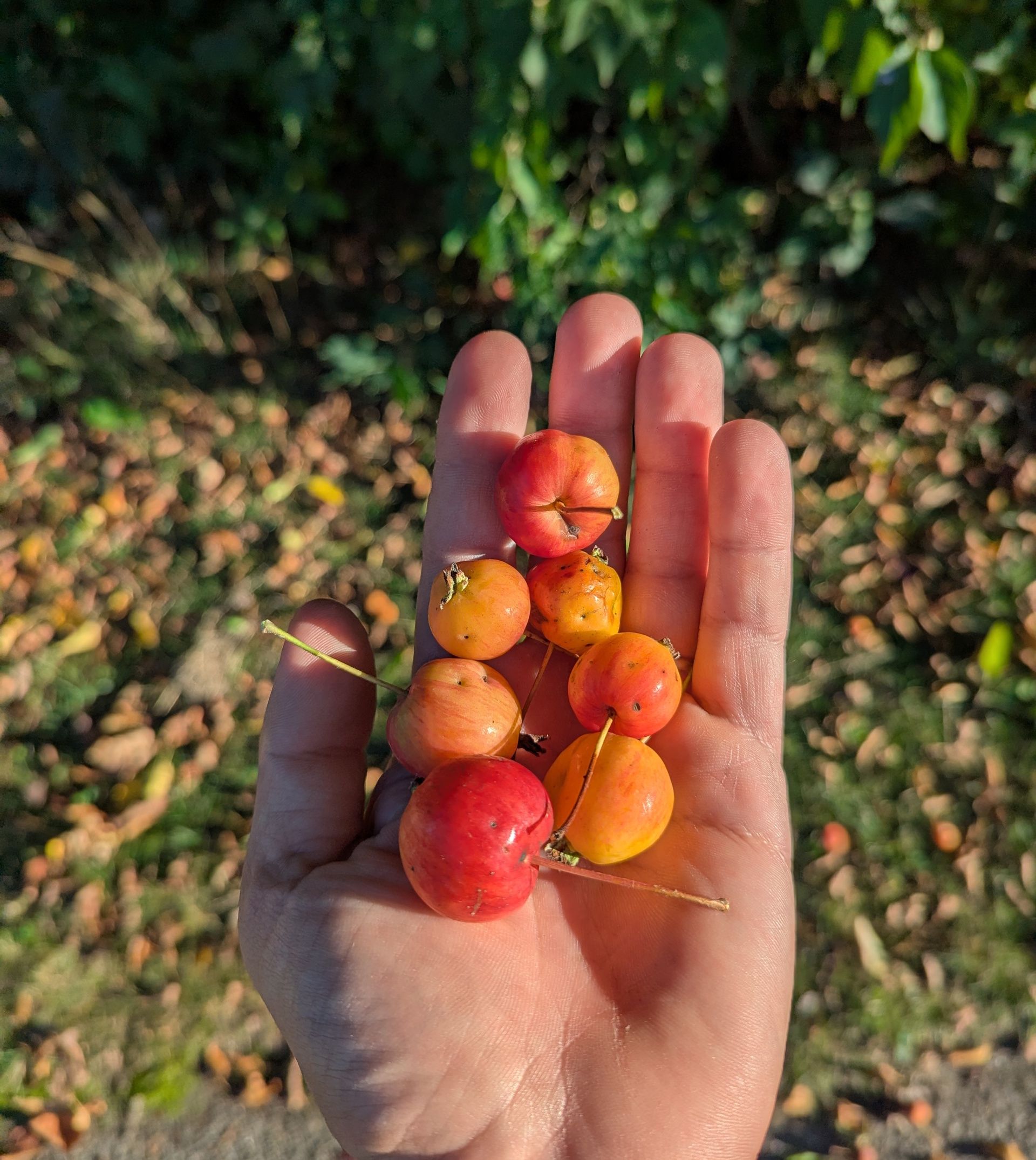- The Naturalist
- Posts
- Apples
Apples
Malus sp.

My absolute favorite apples from a wild rootstock tree
Author’s Note:
It occurred to me that most of you weren’t following this newsletter a few years back when I first put out this article in 2023, and it is definitely apple season!
I’ve been meaning to rewrite parts of this old article now that I have a better format and more practice. That said, please enjoy this updated legacy article on one of my favorite fruit trees:
One of the most iconic fruits in the West is the apple. Every year people crowd to apple orchards during harvest season to eat them fresh, bake with them, and juice them!
My part of Michigan in particular is prime apple country.
Let’s take a look at what there is to know about this seemingly normal fruit:

Bronze-colored feral apples
Plant Profile:
Scientific Name: Malus sp. (species)
Preferred Habitat: I have seen apples mostly on abandoned farmland, in open fields, along edges of woods, and in sunny clearings. They tend to like acidic soil and many of the ones in my area like slightly heavy soils as well. Crabapples may be found in urban areas as ornamentals.
Edible Parts: Fruit, flowers
Distribution: Every state in the U.S. and province in Canada has a species of Malus, however not every species is palatable.

Harvest Season: Some varieties of apple ripen as early as July, and some as late as December or January. This depends heavily on variety and climate, but in the wild I normally find them ripe from late August to mid-November.
Key Identifiers: In the spring the trees blossom and are hard to miss. In the fall, fruit can be seen hanging from branches, and the leaves tend to have an almost leathery appearance.
Toxic Look-Alikes: I have never seen or heard of a fruit that looks enough like an apple in North America to be considered a “look alike”. If you ever plan on using the smaller cherry-sized crabapples though, they can sometimes be confused with Hawthorne berries (which are also edible and related to apples). That said, on other continents I know there exist a few deadly look-alikes!
Nutrition per fruit (1 apple is approximately 180g):
Calories: 94.6
Water: 156g
Protein: 0.43g
Carbs: 25.1g
Sugar: 18.9g
Fiber: 4.37g
Fat: 0.3g
Vitamin C
Potassium
Antioxidants: Quercetin, Catechin, Chlorogenic acid

A beautiful red wild apple, one of my favorites
Uses
Apples have a very long history (one that I will have to save for a special edition). One of the most common places to find feral apples (ones that have gone from being cultivated to wild) is on old farmland.
Apples can be used for jelly, apple butter, sauces, dried/dehydrated, made into baked goods, made into teas, used as a source of sugar, fermented into hard cider or apple cider vinegar which in turn makes a great base for oxymels and non-alcoholic tinctures, eaten fresh, or turned into apple syrup.
At some point I may release a few special recipes for you to try this season since some of the items I listed are pretty obscure and unique!
Crabapples (or even domestic apples) also make excellent pollinators for apples in the garden or orchard!
I have had apples from dozens of different wild trees, and all of them have a wide range of flavors, so you just have to kind of see which ones you prefer.
I’ve noticed some tasting deep and refined like cider with flavorful juice, some taste bland and sweet, others taste tart, one that I tasted had a very odd texture and tasted almost marshmallow sweet. You just have to taste test every tree you come across!

Growth Habits
While there are varieties that do well in warmer climates, most apple trees need a good number of chill hours (hours below freezing) to properly set fruit. That said, most of my recommendations will be for the slightly cooler regions.
Let’s talk about crabapples:
If you’re like me, you may have grown up thinking crabapples would make you sick or give you a stomachache. Well, I’m here to debunk that myth: it’s not true!
Crabapples are just as safe to consume as any other apple since well…they are just undomesticated apples! While they won’t harm you to eat, they vary WIDELY in quality. The majority of ornamental crabapples near me are so small and seedy and bitter that they aren’t worth doing much with, but I have definitely found crabapples that taste great.
One particular tree that I found this year had such a lovely flavor that I had to try to make a ferment with it and it is one of the most beautiful ferments I’ve ever brewed! It also smells delicious. I may have to ferment some into hard cider (this particular batch is for ACV).
One thing to note about apples is that they originated in Kazakhstan. If you ever visit (I plan to someday) you’ll see so many wildly varied apple trees that you’d almost barely recognize as apples. Some grow into tall trees, some are thin shrubs, some even creep along the ground!

A basket of my favorite apples
Additional Information
Apples were domesticated into one major species known as Malus domestica and were spread throughout Asia, Europe, and the Mediterranean regions via the Silk Road and soon were a huge hit worldwide.
They were also a major tree crop in North America when settlers first arrived since most people used them for brewing ciders.
Because of this, you’ll often find apples that don’t seem to taste good when fresh, but are actually leftover cider apple trees.
I say all that to point out that just because an apple doesn’t taste good fresh, it doesn’t mean it is useless!
I have found that most apples I process are perfectly acceptable for sauces and vinegars. That said, if you want that extra level of flavor complexity in baked goods or whatever recipe, I highly recommend using apples from multiple trees.

Golden crabapples
One guy I will probably mention again in the future is Skillcult (Steven Edholm). If you’re interested at all in rare or interesting apple varieties, he’s the guy to watch!
His goal is to selectively breed new and exciting commercial grade apples by crossing old heirloom apples and so far, he’s been quite successful.
Here’s a link to his YouTube channel:

Decorative crabapples in an urban environment
Ok now time for my recommended cultivars! Here’s the thing: I don’t actually like most commercial apples all that much. Everyone knows about the red delicious, gala, fuji, and Macintosh. I want to recommend apples to you that will actually grow well and have a whole other level of good and complex flavor.
That said, if you want traditional classic varieties, go with Honeycrisp or Pink Lady and the average person probably won’t be disappointed in the flavor.
Here’s the good ones:
Apples:
Liberty - One of the most disease and pest resistant apples on the market!
Golden Russet - A Jersey russet type heirloom with beautiful skin and amazing flavor! A top tier cider apple and great for fresh eating and a VERY long storage apple.
Roxbury Russet - The oldest American apple variety from early Southern settlers. Good flavor and a great storage apple.
Rubaiyat
William’s Pride - A very disease-resistant apple that fruits extremely early in the season with good flavor (some report ripe apples in early July)
King David - A highly disease resistant apple with outstanding flavor, also tolerates warmer climates.
Cox Orange Pippin - A highly sought-after apple for breeding with an incredible flavor, great for cider and fresh eating, extremely juicy!
Gravenstein - An outstanding heirloom eating and baking variety with high juice content!
Crabapples:
Chestnut Crabapple - Known for its amazingly complex and unique flavor, hints of caramel and cola flavors are often reported
Robert’s Purple - An anthocyanin-rich crabapple that is excellent for cider (although not as much for eating fresh)
The Dolgo crab - Known for its good pollination and good flavor especially for jelly.
Hylsop - An incredible jelly and pickling crabapple!
Wickson - An absolutely superb apple that is a cross between two other incredible varieties. This is the single best cider apple on the market hands-down. Has an incredibly intense flavor! (Would probably make a delicious vinegar as well).
Centennial - A naturally dwarfing multi-use crab with good flavor and early production! Makes an excellent pollinator for early apples and has pretty good scab resistance.
Skillcult - He doesn’t have a regular stock of apples, but at the end of the season he releases grafting stock, seeds, and pollen from his breeding project. Check in every so often and see what he has, he’s gotten some fascinating results from crossing heirloom apples!

Wild crabapples that had a really lovely flavor
Follow me on social media for behind-the-scenes videos and seasonal photos!
Leave a comment to show the algorithm how legit we are!
Thanks for reading The Naturalist. Please share on social media to support the work!
Reply